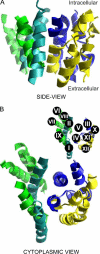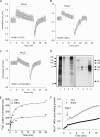Structural modeling and electron paramagnetic resonance spectroscopy of the human Na+/H+ exchanger isoform 1, NHE1
- PMID: 20974853
- PMCID: PMC3013023
- DOI: 10.1074/jbc.M110.159202
Structural modeling and electron paramagnetic resonance spectroscopy of the human Na+/H+ exchanger isoform 1, NHE1
Abstract
We previously presented evidence that transmembrane domain (TM) IV and TM X-XI are important for inhibitor binding and ion transport by the human Na(+)/H(+) exchanger, hNHE1 (Pedersen, S. F., King, S. A., Nygaard, E. B., Rigor, R. R., and Cala, P. M. (2007) J. Biol. Chem. 282, 19716-19727). Here, we present a structural model of the transmembrane part of hNHE1 that further supports this conclusion. The hNHE1 model was based on the crystal structure of the Escherichia coli Na(+)/H(+) antiporter, NhaA, and previous cysteine scanning accessibility studies of hNHE1 and was validated by EPR spectroscopy of spin labels in TM IV and TM XI, as well as by functional analysis of hNHE1 mutants. Removal of all endogenous cysteines in hNHE1, introduction of the mutations A173C (TM IV) and/or I461C (TM XI), and expression of the constructs in mammalian cells resulted in functional hNHE1 proteins. The distance between these spin labels was ∼15 A, confirming that TM IV and TM XI are in close proximity. This distance was decreased both at pH 5.1 and in the presence of the NHE1 inhibitor cariporide. A similar TM IV·TM XI distance and a similar change upon a pH shift were found for the cariporide-insensitive Pleuronectes americanus (pa) NHE1; however, in paNHE1, cariporide had no effect on TM IV·TM XI distance. The central role of the TM IV·TM XI arrangement was confirmed by the partial loss of function upon mutation of Arg(425), which the model predicts stabilizes this arrangement. The data are consistent with a role for TM IV and TM XI rearrangements coincident with ion translocation and inhibitor binding by hNHE1.
Figures









Comment in
-
Two conflicting NHE1 model structures: compatibility with experimental data and implications for the transport mechanism.J Biol Chem. 2011 May 27;286(21):le9; author reply Ie10. doi: 10.1074/jbc.L110.159202. J Biol Chem. 2011. PMID: 21602285 Free PMC article. No abstract available.
Similar articles
-
Two conflicting NHE1 model structures: compatibility with experimental data and implications for the transport mechanism.J Biol Chem. 2011 May 27;286(21):le9; author reply Ie10. doi: 10.1074/jbc.L110.159202. J Biol Chem. 2011. PMID: 21602285 Free PMC article. No abstract available.
-
NHE1 inhibition by amiloride- and benzoylguanidine-type compounds. Inhibitor binding loci deduced from chimeras of NHE1 homologues with endogenous differences in inhibitor sensitivity.J Biol Chem. 2007 Jul 6;282(27):19716-27. doi: 10.1074/jbc.M701637200. Epub 2007 May 10. J Biol Chem. 2007. PMID: 17493937
-
Structural and functional analysis of transmembrane XI of the NHE1 isoform of the Na+/H+ exchanger.J Biol Chem. 2009 Apr 24;284(17):11546-56. doi: 10.1074/jbc.M809201200. Epub 2009 Jan 28. J Biol Chem. 2009. PMID: 19176522 Free PMC article.
-
Structural and functional insights into the cardiac Na⁺/H⁺ exchanger.J Mol Cell Cardiol. 2013 Aug;61:60-7. doi: 10.1016/j.yjmcc.2012.11.019. Epub 2012 Dec 7. J Mol Cell Cardiol. 2013. PMID: 23220151 Review.
-
Site-directed mutations reflecting functional and structural properties of Ec-NhaA.Biochimie. 2021 Jan;180:79-89. doi: 10.1016/j.biochi.2020.10.017. Epub 2020 Oct 28. Biochimie. 2021. PMID: 33129932 Review.
Cited by
-
Antimitochondrial antibody recognition and structural integrity of the inner lipoyl domain of the E2 subunit of pyruvate dehydrogenase complex.J Immunol. 2013 Sep 1;191(5):2126-33. doi: 10.4049/jimmunol.1301092. Epub 2013 Jul 26. J Immunol. 2013. PMID: 23894195 Free PMC article.
-
Determinants of Cation Permeation and Drug Sensitivity in Predicted Transmembrane Helix 9 and Adjoining Exofacial Re-entrant Loop 5 of Na+/H+ Exchanger NHE1.J Biol Chem. 2015 Jul 17;290(29):18173-18186. doi: 10.1074/jbc.M115.642199. Epub 2015 Jun 10. J Biol Chem. 2015. PMID: 26063808 Free PMC article.
-
A Christianson syndrome-linked deletion mutation (∆(287)ES(288)) in SLC9A6 disrupts recycling endosomal function and elicits neurodegeneration and cell death.Mol Neurodegener. 2016 Sep 2;11(1):63. doi: 10.1186/s13024-016-0129-9. Mol Neurodegener. 2016. PMID: 27590723 Free PMC article.
-
Acidic residues of extracellular loop 3 of the Na+/H+ exchanger type 1 are important in cation transport.Mol Cell Biochem. 2020 May;468(1-2):13-20. doi: 10.1007/s11010-020-03707-9. Epub 2020 Mar 4. Mol Cell Biochem. 2020. PMID: 32130622
-
Two conflicting NHE1 model structures: compatibility with experimental data and implications for the transport mechanism.J Biol Chem. 2011 May 27;286(21):le9; author reply Ie10. doi: 10.1074/jbc.L110.159202. J Biol Chem. 2011. PMID: 21602285 Free PMC article. No abstract available.
References
-
- Orlowski J., Grinstein S. (2004) Pflugers Arch. 447, 549–565 - PubMed
-
- Pedersen S. F., O'Donnell M. E., Anderson S. E., Cala P. M. (2006) Am. J. Physiol. Regul. Integr. Comp. Physiol. 291, R1–R25 - PubMed
-
- Wakabayashi S., Pang T., Su X., Shigekawa M. (2000) J. Biol. Chem. 275, 7942–7949 - PubMed
-
- McLean L. A., Zia S., Gorin F. A., Cala P. M. (1999) Am. J. Physiol. 276, C1025–C1037 - PubMed
-
- Pedersen S. F., King S. A., Rigor R. R., Zhuang Z., Cala P. M. (2003) Bull. Mt. Desert Island 42, 38–39
Publication types
MeSH terms
Substances
Grants and funding
LinkOut - more resources
Full Text Sources
Miscellaneous

